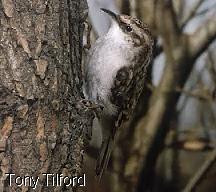

CREEPERS, are any of a dozen species of small slender birds, with downcurved bills, that spiral up tree trunks in search of insects. That are variously classified in the families Certhiidae and Climacteridae, and are any of various small birds that hug tree trunks or rock surfaces as they move about while feeding. The following are songbirds (suborder Passeres; order Passeriformes):
The six species of the genus Certhia constitute the family Certhiidae (order Passeriformes). The best known is C. familiaris, a 13-centimetre- (5-inch-) long streaky brown-and-white bird found in woodlands across the Northern Hemisphere; it is known as treecreeper in Europe and brown creeper in North America. Its tail is stiffened and serves as a prop against the tree. Its nest, a soft cup within a mass of rootlets, is usually placed behind a slab of bark and contains three to nine eggs.
